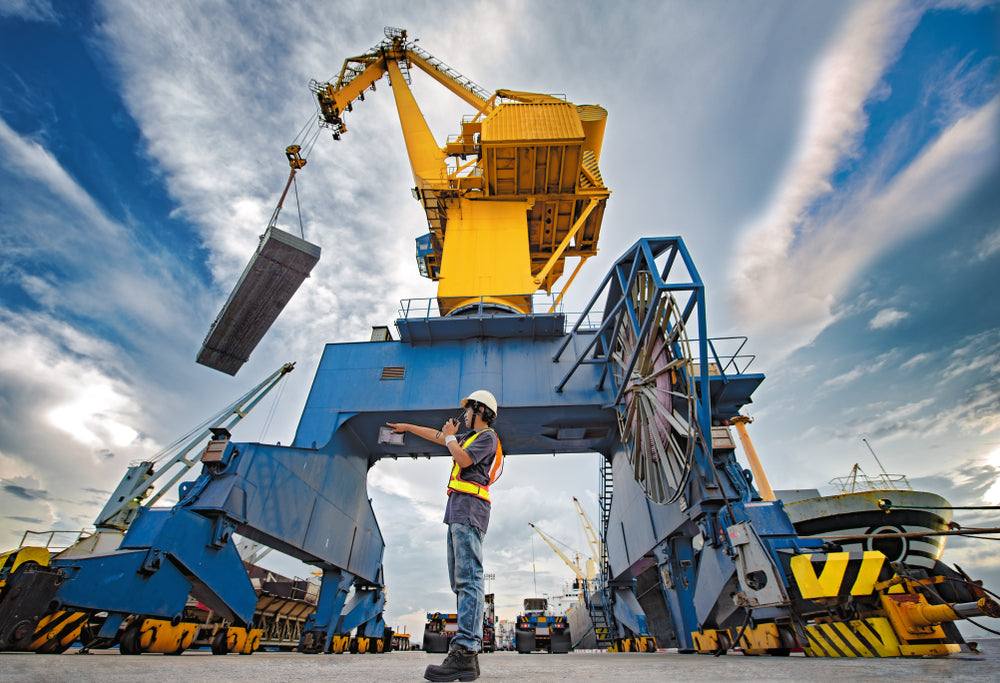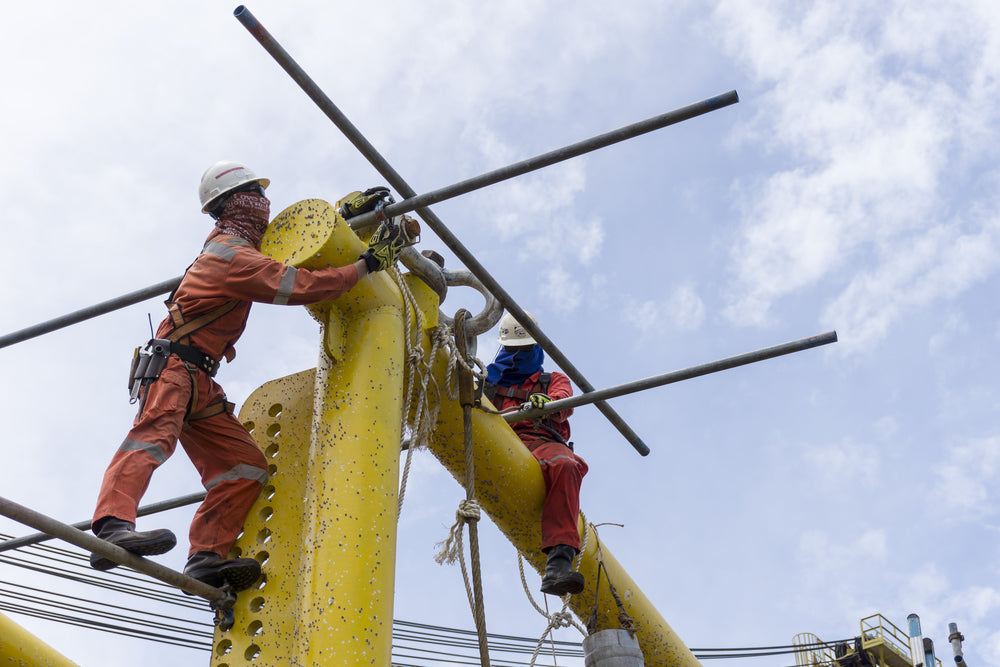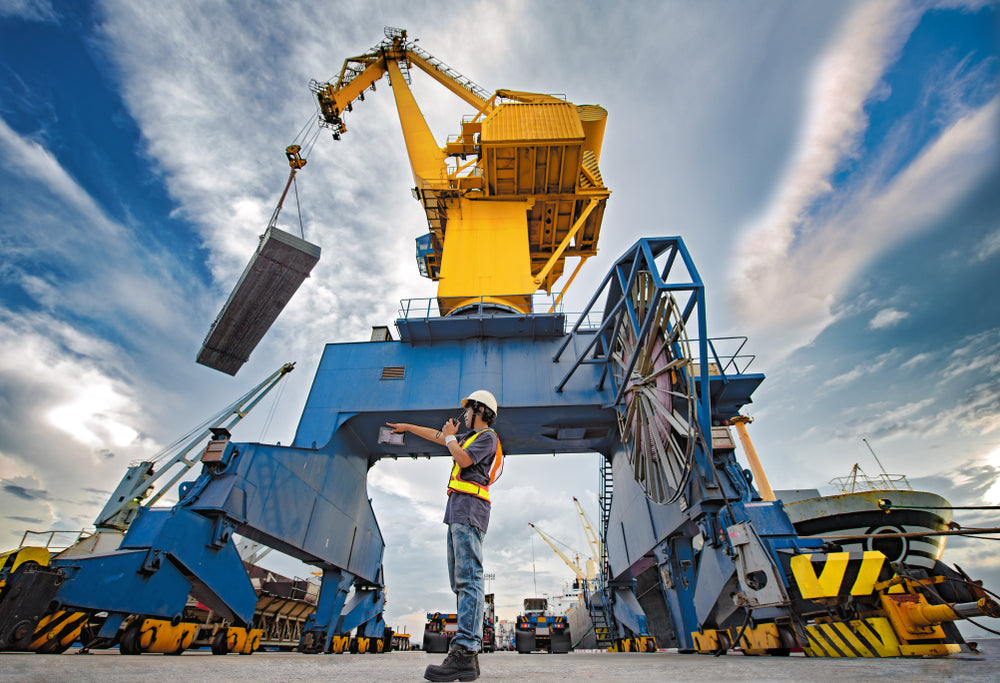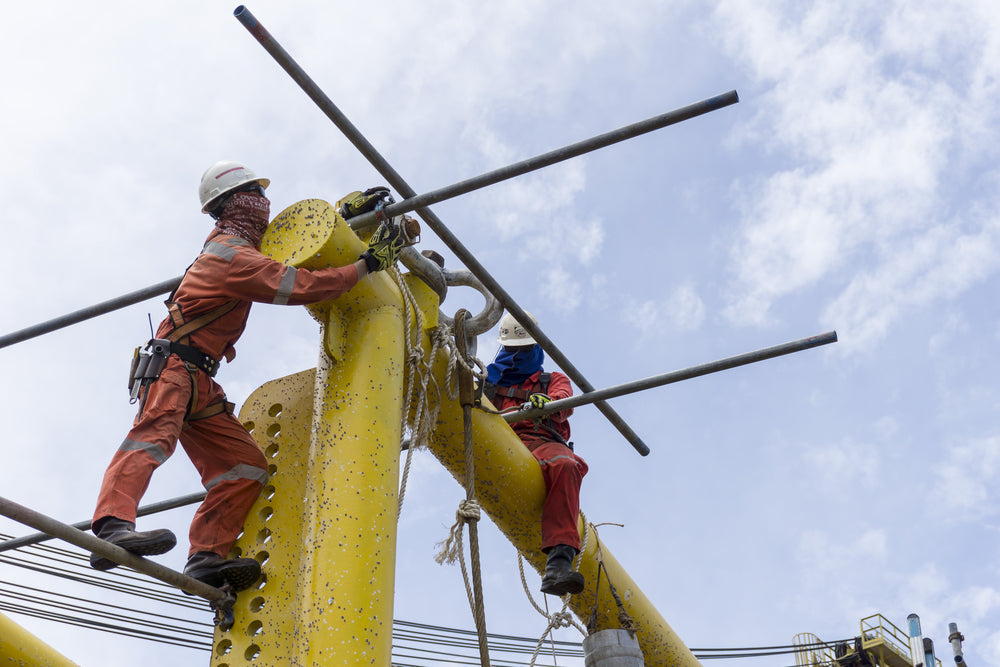CPCCLRG4001 Licence to Perform Rigging Advanced Level Training Course - Salisbury, Brisbane

CPCCLRG4001 Licence to Perform Rigging Advanced Level Training Course - Salisbury, Brisbane
Out of stock
Welcome to CPCCLRG4001 Licence to Perform Rigging Advanced Level Training Course. This is a RA High Risk Work Licence.
This Queensland-based training course specifies the outcomes needed to perform intermediate rigging tasks associated with moving plant and equipment, steel construction, hoists including mast climbing hoists, placement of pre-cast cement, safety nets, static lines, perimeter safety shutters and screens, and safety nets.
After completing the learning activities successfully, the trainer and assessor will assess participants to determine if they are ready for their licencing exam, to be conducted by the High Risk Work (HRW) Assessor
Riggers use mechanical load shifting equipment and associated gear to move, place or secure loads, including plant, equipment or members of a building or structure. Riggers ensure the stability of those members and set up and dismantle cranes and hoists.
This training course applies to rigging work involving:
-
Gin poles and shear legs.
-
Flying foxes and cable ways.
-
Guyed derricks and structures.
-
Suspended scaffolds and fabricated hung scaffolds.
Participants will be trained in the following areas of knowledge and skills in relation to intermediate rigging:
1. Planning tasks
2. Select and inspect rigging equipment
3. Set up of tasks including correct communication and consultation
4. Undertaking intermediate rigging activities
5. Completing tasks.
The OHS.com.au & Kallibr Training Advantage
- Quality training – our sites replicate real-world construction sites and our clients find that highly valuable.
- Convenience - we run an extensive public course schedule and can also do private courses at your worksite.
- Experience - our trainers are from industry and have typically have decades of practical experience which is critical for high risk work environments
Where will the course be held in Queensland?
Training Provider: Kallibr Training (RTO 32365)
Location: Onsite training (Face to face)
Course length: 35 hours (Approx. 5 Days (4 days training plus 1 day assessment)
Certification / Accreditation: Nationally Recognised Statement of Attainment
Pre-requisites: Participants must have completed the unit of competency CPCCLRG3002 Licence to perform rigging intermediate level (or equivalent)
Kallibr Training is operating from Brisbane's largest construction training centre.
It is a licenced, insured and accredited RTO (32365). All the instructors have completed their Certificate IV in Training and Assessment and are highly experienced, vocational trainers.
This fully equipped facility is designed to provide the highest quality training. The training facility is located in Salisbury, offering a large array of equipment, structures and plant for construction, high-risk training, and access.
The Construction Training Centre is located at 460/492 Beaudesert Rd, Salisbury QLD 4107, Australia
Nearest train stations in Brisbane are: Salisbury (Train station), Moorooka (Transit station) and Coopers Plain (Train station).
Directions to 460-492 Beaudesert Road (Salisbury) with public transport.
The following Queensland transport lines have routes that pass near 460-492 Beaudesert Road.
- BusBus: 110,125.
- Train:FERN.
Background - What Sets Advanced Level Rigging Apart From Standard Techniques in Queensland?
Rigging is the process of using ropes, cables, or chains to secure and support heavy equipment or materials during lifting operations.
The purpose of rigging is to ensure the safety of both the load being lifted and the personnel involved in the operation.
It is necessary to follow proper rigging techniques to prevent accidents and damage to equipment.
Standard Rigging Techniques
Rigging involves a variety of standard techniques such as utilising the appropriate types of slings and hardware, calculating load weights, determining the centre of gravity of the load, and selecting the right rigging configuration for the specific lift. These techniques are necessary for ensuring the stability and safety of the load during lifting.
Understanding standard rigging techniques is crucial for anyone involved in lifting operations. It not only ensures the safety of the personnel and equipment but also contributes to the efficiency and success of the lift.
Rigging at an advanced level demands rigorous adherence to safety protocols to mitigate risks for both the workers and the valuable equipment being handled.
This includes comprehensive planning, regular equipment inspections, and continuous monitoring of the rigging operation to ensure a safe working environment.
Plus, in-depth knowledge of load capacities, environmental factors, and potential hazards allows advanced riggers to anticipate challenges and proactively address them to prevent accidents and ensure smooth operations.
Anyone performing construction work must also complete the general construction induction program specified by regulators on a State as well as Federal Government level. This requirement is met by completing CPCCWHS1001 Prepare for work in the construction industry and holding a White Card.
This unit requires a prerequisite. This requirement can be met either by successfully completing the unit CPCCLRG3002 Licence to perform rigging intermediate level (this means that you will have previously also completed a dogging course and a basic rigging course CPCCLRG3001).
Completing this unit is not sufficient to obtain a licence. After competence is assessed under WorkSafe Queensland (WHS) Regulations, a licence can be applied for through the Queensland Government High-Risk Work Licence Service.
It is necessary to familiarise oneself with the different types of rigging hardware used in lifting and moving heavy loads safely.
Understanding how to select the right hardware for the job based on load requirements and environmental factors is paramount. Perceiving the distinctions between hardware types is vital for ensuring the success and safety of rigging operations.
|
Hardware Type |
Description |
|
Shackles |
Used for connecting lifting slings, ropes, chains, or other rigging components. |
|
Slings |
Flexible straps or cables used to secure and lift loads. |
|
Eyebolts |
Bolts with a looped head for attaching rigging equipment. |
|
Hoists |
Mechanical devices used for lifting and lowering heavy objects. |
|
Wire Rope Clips |
Used to create an attachment point on wire rope. |
Rigger licences needed in Queensland
- Basic Rigging Work (RB).
- Intermediate rigging work (RI).
- Advanced Rigging Work (RA).
If you are in the lift or escalator business in Queensland, it may be necessary to have a Rigger's or Dogger's licence.
What will you learn?
-
Review task instructions, consult with relevant persons to seek clarification as required, and obtain relevant workplace information.
-
Obtain and interpret information, including safe work method statements (SWMSs), required to ensure that activities are performed in compliance with workplace-specific and safe work requirements.
-
Obtain and interpret information required to ensure that equipment inspection, use, maintenance and storage complies with manufacturer requirements.
-
Identify workplace and task-specific hazards and determine required risk controls and safety measures and equipment, including signs and barricades, personal protective equipment (PPE), and fall prevention and fall arrest equipment.
-
Identify methods of moving and placing tools, equipment and materials to minimise the risk of falling objects, to avoid inappropriate carrying on ladders and to minimise hazardous manual tasks.
-
Identify required rigging equipment and associated gear.
-
Calculate loads associated with mechanical load shifting equipment and associated gear required to erect and dismantle structures and plant.
-
Select and check PPE.
-
Select rigging equipment and associated gear, inspect for defects, and isolate, tag out, report and record defective items.
-
Select communication equipment and check that it is working and fit for use.
-
Establish and maintain communication with relevant persons to ensure task plan and risk controls are communicated clearly, including any impact on other workplace activities.
-
Ensure risk controls and safety measures and equipment have been put in place, including the fitting, adjusting and anchoring of fall protection equipment.
-
Consult with relevant persons to ensure that ground and foundation have been assessed as suitable for task.
-
Consult with relevant persons to ensure that the structure has been assessed as suitable for load bearing task.
-
Erect, operate and dismantle all structures and plant while maintaining stability, in accordance with workplace and manufacturer requirements.
Upon successful completion of this course, student will be awarded a Statement of Attainment and the High-Risk Work Licence to Perform Rigging Basic Level by WorkSafe Queensland.
Course outcomes
- Statement of Attainment Nationally Accredited .
- Apply for a RA High Risk Work licence.
- Advanced rigging skills to safely install and dismantle equipment or structures.
- Credit towards a full qualification.
- You can apply for a advanced rigging licence if you have the required skills.
- Continue your education and improve your career prospects with these strong pathways.
Entry requirements
- A valid intermediate rigging licence or unit of competency.
- Reached 18 years of age to sit the SafeWork Queensland assessment.
- A general construction induction card (commonly known as a white card).
- Proof of Queensland residential address
- 100 points for identification for the SafeWork assessment.
The application form for a new Queensland HRW Licence must be completed online on the Worksafe QLD site.
The application must be submitted within 60 days after the successful completion of the practical assessment.
A Candidate Assessment Summary (CAS) is a document that shows the results of an assessment or part of an assessment. Students should keep their CAS as well as the proof of payment for the application for the licence to legally prove they can lawfully perform the work until they receive their HRW licence.
Workplace Health and Safety QLD can be contacted on 1300 369 911 for any questions regarding your application.
SKU:
Course Highlights:
- 5 days Face-to-Face
- Expert-Led + Practical
- Quality Focused
- Fast Certification
- Tax Deductable
- Trusted RTO Provider
- Statement of Attainment
- Nationally Recognised
Couldn't load pickup availability

"Well run course! The trainer was very efficient, well prepared, communicated clearly what we would cover and finished on time 👍"
Nathan"Good customer service great knowledge and understanding from the trainers couldn’t recommend a better place to be trained"
Melanie"The course was very informative. Going into the course I didn’t think I’d learn anything new but I was astonished with how much I learnt."
Paul.P"This course was Informative and practical shout out to John for leading the session."
JayADDITIONAL EXTRA BONUSES with OHS.com.au
Claim up to $1271.95 worth of Extra Bonuses
with every purchase
- Your personal copy of Safety Legends E-Book (value $39.95)
- $100 off your first case from Naked Wines (value $100)
- Upto 350,000 Bonus AMEX Frequent Flyer points* (value $1000)
- Complimentary Access to two online courses** (value $132)
$1271.95 EXTRA VALUE - JUST FOR YOU INSIDE!
* New customers when you successfully sign up for a new personal / business credit card ** Indigenous Cultural Awareness / Impacts of Climate Change coursesDescription
Welcome to CPCCLRG4001 Licence to Perform Rigging Advanced Level Training Course. This is a RA High Risk Work Licence.
This Queensland-based training course specifies the outcomes needed to perform intermediate rigging tasks associated with moving plant and equipment, steel construction, hoists including mast climbing hoists, placement of pre-cast cement, safety nets, static lines, perimeter safety shutters and screens, and safety nets.
After completing the learning activities successfully, the trainer and assessor will assess participants to determine if they are ready for their licencing exam, to be conducted by the High Risk Work (HRW) Assessor
Riggers use mechanical load shifting equipment and associated gear to move, place or secure loads, including plant, equipment or members of a building or structure. Riggers ensure the stability of those members and set up and dismantle cranes and hoists.
This training course applies to rigging work involving:
-
Gin poles and shear legs.
-
Flying foxes and cable ways.
-
Guyed derricks and structures.
-
Suspended scaffolds and fabricated hung scaffolds.
Participants will be trained in the following areas of knowledge and skills in relation to intermediate rigging:
1. Planning tasks
2. Select and inspect rigging equipment
3. Set up of tasks including correct communication and consultation
4. Undertaking intermediate rigging activities
5. Completing tasks.
The OHS.com.au & Kallibr Training Advantage
- Quality training – our sites replicate real-world construction sites and our clients find that highly valuable.
- Convenience - we run an extensive public course schedule and can also do private courses at your worksite.
- Experience - our trainers are from industry and have typically have decades of practical experience which is critical for high risk work environments
Where will the course be held in Queensland?
Training Provider: Kallibr Training (RTO 32365)
Location: Onsite training (Face to face)
Course length: 35 hours (Approx. 5 Days (4 days training plus 1 day assessment)
Certification / Accreditation: Nationally Recognised Statement of Attainment
Pre-requisites: Participants must have completed the unit of competency CPCCLRG3002 Licence to perform rigging intermediate level (or equivalent)
Kallibr Training is operating from Brisbane's largest construction training centre.
It is a licenced, insured and accredited RTO (32365). All the instructors have completed their Certificate IV in Training and Assessment and are highly experienced, vocational trainers.
This fully equipped facility is designed to provide the highest quality training. The training facility is located in Salisbury, offering a large array of equipment, structures and plant for construction, high-risk training, and access.
The Construction Training Centre is located at 460/492 Beaudesert Rd, Salisbury QLD 4107, Australia
Nearest train stations in Brisbane are: Salisbury (Train station), Moorooka (Transit station) and Coopers Plain (Train station).
Directions to 460-492 Beaudesert Road (Salisbury) with public transport.
The following Queensland transport lines have routes that pass near 460-492 Beaudesert Road.
- BusBus: 110,125.
- Train:FERN.
Background - What Sets Advanced Level Rigging Apart From Standard Techniques in Queensland?
Rigging is the process of using ropes, cables, or chains to secure and support heavy equipment or materials during lifting operations.
The purpose of rigging is to ensure the safety of both the load being lifted and the personnel involved in the operation.
It is necessary to follow proper rigging techniques to prevent accidents and damage to equipment.
Standard Rigging Techniques
Rigging involves a variety of standard techniques such as utilising the appropriate types of slings and hardware, calculating load weights, determining the centre of gravity of the load, and selecting the right rigging configuration for the specific lift. These techniques are necessary for ensuring the stability and safety of the load during lifting.
Understanding standard rigging techniques is crucial for anyone involved in lifting operations. It not only ensures the safety of the personnel and equipment but also contributes to the efficiency and success of the lift.
Rigging at an advanced level demands rigorous adherence to safety protocols to mitigate risks for both the workers and the valuable equipment being handled.
This includes comprehensive planning, regular equipment inspections, and continuous monitoring of the rigging operation to ensure a safe working environment.
Plus, in-depth knowledge of load capacities, environmental factors, and potential hazards allows advanced riggers to anticipate challenges and proactively address them to prevent accidents and ensure smooth operations.
Anyone performing construction work must also complete the general construction induction program specified by regulators on a State as well as Federal Government level. This requirement is met by completing CPCCWHS1001 Prepare for work in the construction industry and holding a White Card.
This unit requires a prerequisite. This requirement can be met either by successfully completing the unit CPCCLRG3002 Licence to perform rigging intermediate level (this means that you will have previously also completed a dogging course and a basic rigging course CPCCLRG3001).
Completing this unit is not sufficient to obtain a licence. After competence is assessed under WorkSafe Queensland (WHS) Regulations, a licence can be applied for through the Queensland Government High-Risk Work Licence Service.
It is necessary to familiarise oneself with the different types of rigging hardware used in lifting and moving heavy loads safely.
Understanding how to select the right hardware for the job based on load requirements and environmental factors is paramount. Perceiving the distinctions between hardware types is vital for ensuring the success and safety of rigging operations.
|
Hardware Type |
Description |
|
Shackles |
Used for connecting lifting slings, ropes, chains, or other rigging components. |
|
Slings |
Flexible straps or cables used to secure and lift loads. |
|
Eyebolts |
Bolts with a looped head for attaching rigging equipment. |
|
Hoists |
Mechanical devices used for lifting and lowering heavy objects. |
|
Wire Rope Clips |
Used to create an attachment point on wire rope. |
Rigger licences needed in Queensland
- Basic Rigging Work (RB).
- Intermediate rigging work (RI).
- Advanced Rigging Work (RA).
If you are in the lift or escalator business in Queensland, it may be necessary to have a Rigger's or Dogger's licence.
What will you learn?
-
Review task instructions, consult with relevant persons to seek clarification as required, and obtain relevant workplace information.
-
Obtain and interpret information, including safe work method statements (SWMSs), required to ensure that activities are performed in compliance with workplace-specific and safe work requirements.
-
Obtain and interpret information required to ensure that equipment inspection, use, maintenance and storage complies with manufacturer requirements.
-
Identify workplace and task-specific hazards and determine required risk controls and safety measures and equipment, including signs and barricades, personal protective equipment (PPE), and fall prevention and fall arrest equipment.
-
Identify methods of moving and placing tools, equipment and materials to minimise the risk of falling objects, to avoid inappropriate carrying on ladders and to minimise hazardous manual tasks.
-
Identify required rigging equipment and associated gear.
-
Calculate loads associated with mechanical load shifting equipment and associated gear required to erect and dismantle structures and plant.
-
Select and check PPE.
-
Select rigging equipment and associated gear, inspect for defects, and isolate, tag out, report and record defective items.
-
Select communication equipment and check that it is working and fit for use.
-
Establish and maintain communication with relevant persons to ensure task plan and risk controls are communicated clearly, including any impact on other workplace activities.
-
Ensure risk controls and safety measures and equipment have been put in place, including the fitting, adjusting and anchoring of fall protection equipment.
-
Consult with relevant persons to ensure that ground and foundation have been assessed as suitable for task.
-
Consult with relevant persons to ensure that the structure has been assessed as suitable for load bearing task.
-
Erect, operate and dismantle all structures and plant while maintaining stability, in accordance with workplace and manufacturer requirements.
Upon successful completion of this course, student will be awarded a Statement of Attainment and the High-Risk Work Licence to Perform Rigging Basic Level by WorkSafe Queensland.
Course outcomes
- Statement of Attainment Nationally Accredited .
- Apply for a RA High Risk Work licence.
- Advanced rigging skills to safely install and dismantle equipment or structures.
- Credit towards a full qualification.
- You can apply for a advanced rigging licence if you have the required skills.
- Continue your education and improve your career prospects with these strong pathways.
Entry requirements
- A valid intermediate rigging licence or unit of competency.
- Reached 18 years of age to sit the SafeWork Queensland assessment.
- A general construction induction card (commonly known as a white card).
- Proof of Queensland residential address
- 100 points for identification for the SafeWork assessment.
The application form for a new Queensland HRW Licence must be completed online on the Worksafe QLD site.
The application must be submitted within 60 days after the successful completion of the practical assessment.
A Candidate Assessment Summary (CAS) is a document that shows the results of an assessment or part of an assessment. Students should keep their CAS as well as the proof of payment for the application for the licence to legally prove they can lawfully perform the work until they receive their HRW licence.
Workplace Health and Safety QLD can be contacted on 1300 369 911 for any questions regarding your application.
- Money Back Guarantee
- Save Time & Money
- Tax Deductible
- 1000's Trained Each Month
- Quality-Focused
- Peer Reviewed Courses
- Trusted Industry Partner
- Fast Certification
- 60 Day Guarantee
- *See refund policy


Got multiple people needing to do a course? We will get back to you within a day!
Student Reviews

Couldn't load pickup availability

Contact Us!
Contact form
ADDITIONAL EXTRA BONUSES with OHS.com.au
Claim up to $1271.95 worth of Extra Bonuses
with every purchase
- Your personal copy of Safety Legends E-Book (value $39.95)
- $100 off your first case from Naked Wines (value $100)
- Upto 350,000 Bonus AMEX Frequent Flyer points* (value $1000)
- Complimentary Access to two online courses** (value $132)
$1271.95 EXTRA VALUE - JUST FOR YOU INSIDE!
* New customers when you successfully sign up for a new personal / business credit card ** Indigenous Cultural Awareness / Impacts of Climate Change coursesDescription
Welcome to CPCCLRG4001 Licence to Perform Rigging Advanced Level Training Course. This is a RA High Risk Work Licence.
This Queensland-based training course specifies the outcomes needed to perform intermediate rigging tasks associated with moving plant and equipment, steel construction, hoists including mast climbing hoists, placement of pre-cast cement, safety nets, static lines, perimeter safety shutters and screens, and safety nets.
After completing the learning activities successfully, the trainer and assessor will assess participants to determine if they are ready for their licencing exam, to be conducted by the High Risk Work (HRW) Assessor
Riggers use mechanical load shifting equipment and associated gear to move, place or secure loads, including plant, equipment or members of a building or structure. Riggers ensure the stability of those members and set up and dismantle cranes and hoists.
This training course applies to rigging work involving:
-
Gin poles and shear legs.
-
Flying foxes and cable ways.
-
Guyed derricks and structures.
-
Suspended scaffolds and fabricated hung scaffolds.
Participants will be trained in the following areas of knowledge and skills in relation to intermediate rigging:
1. Planning tasks
2. Select and inspect rigging equipment
3. Set up of tasks including correct communication and consultation
4. Undertaking intermediate rigging activities
5. Completing tasks.
The OHS.com.au & Kallibr Training Advantage
- Quality training – our sites replicate real-world construction sites and our clients find that highly valuable.
- Convenience - we run an extensive public course schedule and can also do private courses at your worksite.
- Experience - our trainers are from industry and have typically have decades of practical experience which is critical for high risk work environments
Where will the course be held in Queensland?
Training Provider: Kallibr Training (RTO 32365)
Location: Onsite training (Face to face)
Course length: 35 hours (Approx. 5 Days (4 days training plus 1 day assessment)
Certification / Accreditation: Nationally Recognised Statement of Attainment
Pre-requisites: Participants must have completed the unit of competency CPCCLRG3002 Licence to perform rigging intermediate level (or equivalent)
Kallibr Training is operating from Brisbane's largest construction training centre.
It is a licenced, insured and accredited RTO (32365). All the instructors have completed their Certificate IV in Training and Assessment and are highly experienced, vocational trainers.
This fully equipped facility is designed to provide the highest quality training. The training facility is located in Salisbury, offering a large array of equipment, structures and plant for construction, high-risk training, and access.
The Construction Training Centre is located at 460/492 Beaudesert Rd, Salisbury QLD 4107, Australia
Nearest train stations in Brisbane are: Salisbury (Train station), Moorooka (Transit station) and Coopers Plain (Train station).
Directions to 460-492 Beaudesert Road (Salisbury) with public transport.
The following Queensland transport lines have routes that pass near 460-492 Beaudesert Road.
- BusBus: 110,125.
- Train:FERN.
Background - What Sets Advanced Level Rigging Apart From Standard Techniques in Queensland?
Rigging is the process of using ropes, cables, or chains to secure and support heavy equipment or materials during lifting operations.
The purpose of rigging is to ensure the safety of both the load being lifted and the personnel involved in the operation.
It is necessary to follow proper rigging techniques to prevent accidents and damage to equipment.
Standard Rigging Techniques
Rigging involves a variety of standard techniques such as utilising the appropriate types of slings and hardware, calculating load weights, determining the centre of gravity of the load, and selecting the right rigging configuration for the specific lift. These techniques are necessary for ensuring the stability and safety of the load during lifting.
Understanding standard rigging techniques is crucial for anyone involved in lifting operations. It not only ensures the safety of the personnel and equipment but also contributes to the efficiency and success of the lift.
Rigging at an advanced level demands rigorous adherence to safety protocols to mitigate risks for both the workers and the valuable equipment being handled.
This includes comprehensive planning, regular equipment inspections, and continuous monitoring of the rigging operation to ensure a safe working environment.
Plus, in-depth knowledge of load capacities, environmental factors, and potential hazards allows advanced riggers to anticipate challenges and proactively address them to prevent accidents and ensure smooth operations.
Anyone performing construction work must also complete the general construction induction program specified by regulators on a State as well as Federal Government level. This requirement is met by completing CPCCWHS1001 Prepare for work in the construction industry and holding a White Card.
This unit requires a prerequisite. This requirement can be met either by successfully completing the unit CPCCLRG3002 Licence to perform rigging intermediate level (this means that you will have previously also completed a dogging course and a basic rigging course CPCCLRG3001).
Completing this unit is not sufficient to obtain a licence. After competence is assessed under WorkSafe Queensland (WHS) Regulations, a licence can be applied for through the Queensland Government High-Risk Work Licence Service.
It is necessary to familiarise oneself with the different types of rigging hardware used in lifting and moving heavy loads safely.
Understanding how to select the right hardware for the job based on load requirements and environmental factors is paramount. Perceiving the distinctions between hardware types is vital for ensuring the success and safety of rigging operations.
|
Hardware Type |
Description |
|
Shackles |
Used for connecting lifting slings, ropes, chains, or other rigging components. |
|
Slings |
Flexible straps or cables used to secure and lift loads. |
|
Eyebolts |
Bolts with a looped head for attaching rigging equipment. |
|
Hoists |
Mechanical devices used for lifting and lowering heavy objects. |
|
Wire Rope Clips |
Used to create an attachment point on wire rope. |
Rigger licences needed in Queensland
- Basic Rigging Work (RB).
- Intermediate rigging work (RI).
- Advanced Rigging Work (RA).
If you are in the lift or escalator business in Queensland, it may be necessary to have a Rigger's or Dogger's licence.
What will you learn?
-
Review task instructions, consult with relevant persons to seek clarification as required, and obtain relevant workplace information.
-
Obtain and interpret information, including safe work method statements (SWMSs), required to ensure that activities are performed in compliance with workplace-specific and safe work requirements.
-
Obtain and interpret information required to ensure that equipment inspection, use, maintenance and storage complies with manufacturer requirements.
-
Identify workplace and task-specific hazards and determine required risk controls and safety measures and equipment, including signs and barricades, personal protective equipment (PPE), and fall prevention and fall arrest equipment.
-
Identify methods of moving and placing tools, equipment and materials to minimise the risk of falling objects, to avoid inappropriate carrying on ladders and to minimise hazardous manual tasks.
-
Identify required rigging equipment and associated gear.
-
Calculate loads associated with mechanical load shifting equipment and associated gear required to erect and dismantle structures and plant.
-
Select and check PPE.
-
Select rigging equipment and associated gear, inspect for defects, and isolate, tag out, report and record defective items.
-
Select communication equipment and check that it is working and fit for use.
-
Establish and maintain communication with relevant persons to ensure task plan and risk controls are communicated clearly, including any impact on other workplace activities.
-
Ensure risk controls and safety measures and equipment have been put in place, including the fitting, adjusting and anchoring of fall protection equipment.
-
Consult with relevant persons to ensure that ground and foundation have been assessed as suitable for task.
-
Consult with relevant persons to ensure that the structure has been assessed as suitable for load bearing task.
-
Erect, operate and dismantle all structures and plant while maintaining stability, in accordance with workplace and manufacturer requirements.
Upon successful completion of this course, student will be awarded a Statement of Attainment and the High-Risk Work Licence to Perform Rigging Basic Level by WorkSafe Queensland.
Course outcomes
- Statement of Attainment Nationally Accredited .
- Apply for a RA High Risk Work licence.
- Advanced rigging skills to safely install and dismantle equipment or structures.
- Credit towards a full qualification.
- You can apply for a advanced rigging licence if you have the required skills.
- Continue your education and improve your career prospects with these strong pathways.
Entry requirements
- A valid intermediate rigging licence or unit of competency.
- Reached 18 years of age to sit the SafeWork Queensland assessment.
- A general construction induction card (commonly known as a white card).
- Proof of Queensland residential address
- 100 points for identification for the SafeWork assessment.
The application form for a new Queensland HRW Licence must be completed online on the Worksafe QLD site.
The application must be submitted within 60 days after the successful completion of the practical assessment.
A Candidate Assessment Summary (CAS) is a document that shows the results of an assessment or part of an assessment. Students should keep their CAS as well as the proof of payment for the application for the licence to legally prove they can lawfully perform the work until they receive their HRW licence.
Workplace Health and Safety QLD can be contacted on 1300 369 911 for any questions regarding your application.
- Money Back Guarantee
- Save Time & Money
- Tax Deductible
- 1000's Trained Each Month
- Quality-Focused
- Peer Reviewed Courses
- Trusted Industry Partner
- Fast Certification
- 60 Day Guarantee
- *See refund policy
Student Reviews

Course Highlights:
- 5 days Face-to-Face
- Expert-Led + Practical
- Quality Focused
- Fast Certification
- Tax Deductable
- Trusted RTO Provider
- Statement of Attainment
- Nationally Recognised
Couldn't load pickup availability

"Well run course! The trainer was very efficient, well prepared, communicated clearly what we would cover and finished on time 👍"
Nathan"Good customer service great knowledge and understanding from the trainers couldn’t recommend a better place to be trained"
Melanie"The course was very informative. Going into the course I didn’t think I’d learn anything new but I was astonished with how much I learnt."
Paul.P"This course was Informative and practical shout out to John for leading the session."
Jay




Are you from a large organisation? Contact us for a group quote!
 Checkout securely with
Checkout securely with
With the need for easy access to training, OHS was launched to provide practical online health and safety courses. We aim to provide professionals with high-quality, flexible training solutions that allow them to refresh their knowledge as needed without disrupting their busy schedules.
OHS is a leader in professional training, delivering flexible, cost-effective options such as NDIS Training, Safety Training, Staff Training and VOCs/High Risk Refreshers, making sure you stay compliant and relevant amidst the fast-paced demands of today's world. With us, you won't need to look up 'Learning Development Hr', 'First Aid Training Surrey' or 'First Aid Training Dandenong' again.
At OHS, you can tailor your training to your schedule and select either single courses or an annual subscription that grants you unlimited access. Instead of scrolling through results for search terms like 'management training courses', 'manual handling training canberra' or 'asbestos and silica awareness training', contact us to learn more or buy a course today.
 1300 307 445
1300 307 445



